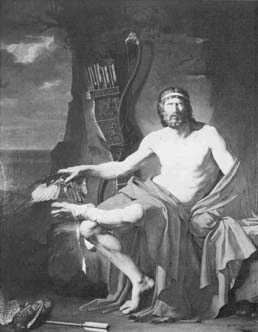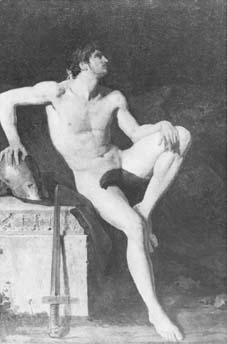
Annual Bulletin 7, 1983-1984
Home
Français
Introduction
History
Annual Index
Author &
Subject
Credits
Contact




The Shepherd Paris of
Jean-Germain Drouais
by John D. Bandiera
Pages 1 | 2
| 3
| 4
| 5
| 6
| 7
In 1980 the National Gallery of Canada acquired The Shepherd Paris
(fig. 1), a large "académie" attributed to
Drouais. (12) In this very fine work, the youthful Paris, who according to
legend was living as a shepherd on the slopes of Mount Ida, is shown standing
before a naturalistic and somewhat melancholy landscape. The subject,
of which there are numerous examples in painting and sculpture from antiquity
to the nineteenth century, (13) is linked to the (more familiar) iconographic
tradition of The Judgment of Paris. The author of The Shepherd Paris depicts
the moment preceding the judgment of the 'beauty contest' between Hera,
Athena, and Aphrodite by Paris, the son of Priam and "the handsomest of
all mortal men." (14) Paris contemplates the prize, a golden apple delivered
to him by Mercury, who can be discerned flying away in the top left-hand
corner of the painting. It is probable that Paris is studying his own reflection
in the apple, but his pensive countenance also suggests the dawning awareness
of the significance of his fateful decision - one that will lead directly
to the outbreak of the Trojan War. By having Paris contemplate his own
reflection, the artist creates an emotionally charged and introspective
mood. The landscape, with its clouds, blowing trees, and inconspicuous
doric temple in the far-off wooded area to the left, also contributes to
the general wistfulness and the romantic sense of a faraway place and time.
The understated emotionalism and quiet lyricism of The Shepherd Paris, as well as the elegant proportions and suave painting of the
figure and the lively treatment of the landscape, all point to an artist
possessed of both skin and sensitivity. Yet, although the extraordinary
quality of this work is unquestioned, its authorship is still in dispute.
Scholars have been unwilling to accept the attribution to Drouais (the
most recent open challenge was in the catalogue of the David et Rome
exhibition of 1981-82) for three compelling reasons. (15) The first is
that the signature, "Drouais. f. Roma," is at least partially (and, in all
likelihood, completely) spurious. (16) The second is that there is no reference
in the literature to a Shepherd Paris by Drouais' hand. Third, the painting
is thought to be out of place stylistically and thematically with the certified
Drouais académies. (17) Indeed, if we are to accept The Shepherd Paris
as a work by Drouais, we must alter our perception of the character
of Drouais' oeuvre and reconsider the chronology of his works and his artistic
development. This study win introduce evidence that supports an attribution
of The Shepherd Paris to Drouais and sheds new light on his output
and interests during his years in Rome.
By virtue of its dimensions and mythological pretext,
it is probable that The Shepherd Paris was executed as an "envoi
de Rome" (18) - a figure study painted by a pensionnaire at the French Academy
in Rome and intended to be sent to Paris for presentation at the Royal
Academy of Painting and Sculpture. (Normally a student would be required
to execute one painted académie per year and four finished drawings
of nude figures.) The painting's style and content also tie in neatly
with the kind of "académies peintes" that were executed by David
students in the 1780s. Therefore, The Shepherd Paris can be situated
in the general time frame for an attribution to Drouais, who was in residence
at the French Academy in Rome from 7 October 1784 until 13 February 1788.
Could it have been painted by Drouais during these forty
months? Unfortunately, the picture's provenance cannot be traced farther
back than the dealer from which it was purchased and, as has been noted,
there is no contemporary documentation. However, it is possible to focus
on a specific period within the forty months since we know when Drouais
could not have painted The Shepherd Paris. In a letter of
9 April 1788 to d'Angivillier, "Surintendant des Bâtiments du Roi",
Ménageot, who was the Director of the French Academy in Rome, wrote,
"Le Sr Drouais n'a rien laissé du tout en peinture; il n'avait que
son académie, en tout il n'a laissé que très peu d'études." (19)
Therefore, at his death, Drouais' studio contained only his Philoctetes
(fig. 2) and preliminary studies for his unfinished painting, The
Departure of Gaius Gracchus. (No doubt there were also sketches for
the copy of Domenichino's Adam and Eve, which Drouais had been ordered to paint for the king.)
It is therefore inconceivable, especially considering Drouais' failing health in the last year of his life, that
he would have worked on any other projects than these in the period from
late 1786, when he began his Philoctetes and The Departure of Gaius
Gracchus, until his death.
It is equally unlikely that Drouais would have painted
The Shepherd Paris in the period from August 1785, when he exhibited his Dying Athlete (fig. 3), to late
1786. (20) A letter of 23 August 1786 from Lagrenée (Director of the Academy before Ménageot)
to d'Angivillier informs us that Drouais bad been exempted from the requirement
that he execute an académie for 1786 so that he could devote full
attention to Marius at Minturnae (which required about eleven
months to complete). (21) If The Shepherd Paris was painted by Drouais,
it could have only been executed in the eleven-month period from his arrival
in Rome to August 1785, and it is precisely there that we must look for
answers to the question of authorship.
This was the most productive period of Drouais' career. His biographers tell us that he gave himself over completely to work, rising
at four in the morning and working, sometimes without pausing for nourishment,
until night-time. (22) In addition to the Dying Athlete, Drouais
painted a Head of an Old Man (now lost) and helped David with his The Oath of the Horatii. (23) To this period we must also assign one
other work for which there is no eighteenth-century documentation: the
(so-called) Seated Gladiator (fig. 4) in Rouen (which some writers
have confused with the Dying Athlete). (24) The conventional view
is that the Seated Gladiator is an unfinished preliminary version
of the Dying Athlete. But although there are similarities of theme,
style, and ethos, the Seated Gladiator is probably not a preliminary
work. The fact that the Rouen nude wears the laurels of the victor and
is unwounded indicates this is a different conception from the Dying
Athlete (described in the Journal de Paris "Nécrologie"
of 1788 as "...un Gladiateur vaincu et blessé, dans les yeux
duquel on voyoit encore briller le désir de la vengeance."). (25) As
opposed to the Roman type of the Dying Athlete, the Rouen work probably
depicts a Greek hero (certainly the helmet is Greek) who looks upward
for divine guidance or to give thanks. (26)
We now know of at least one subject, for which there are no
contemporary documents, that Drouais executed during his early years in
Rome. Would it then be too speculative to consider the possibility that
there is another and that this is The Shepherd Paris? I think not,
since the evidence provided by connoisseurship strongly suggests that it
is connected to the three certified Drouais académies. The most
obvious similarity is the pose - in all four pictures the figures lean back
on one arm, while the other arm is bent. (Furthermore, in every work there
are draperies beneath the figures.) (27) The torsos of all four figures are
gracefully curved, and three of them have their legs crossed. In all four,
the angle of the heads, which seems to continue the curve of the bodies,
is comparable.
There is also great similarity in the diagonal compositions
of the four pictures and in the relationship of the figures to the surrounding
space. In every instance, space is compressed behind the figure and opened
up on the opposite side. This serves to isolate the figures (which occupy
a comparable amount of pictorial space relative to the whole) and to create
a meditative space around them. One can also point to the similarity of
mood; all the figures are pensive and withdrawn, and each picture conveys
a feeling of solemnity and seriousness.
Next Page | similarity
in diagonal compositions
1 | 2
| 3
| 4
| 5
| 6
| 7
Annual Index | Author & Subject | Credits | Contact
This digital collection
was produced under contract to Canada's Digital Collections program,
Industry Canada.
"Digital
Collections Program, Copyright
© National Gallery of
Canada 2001"